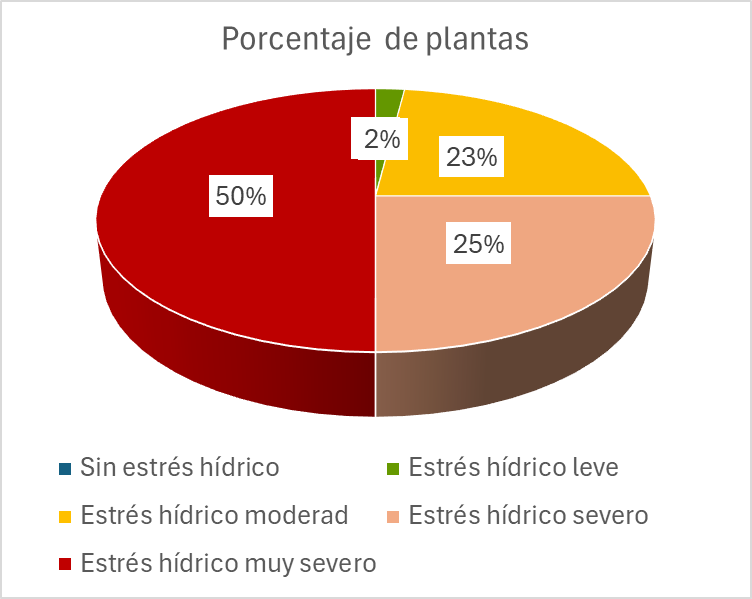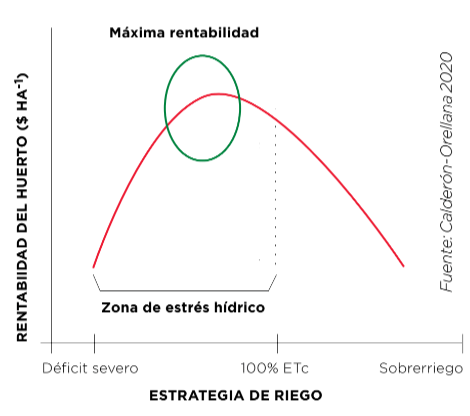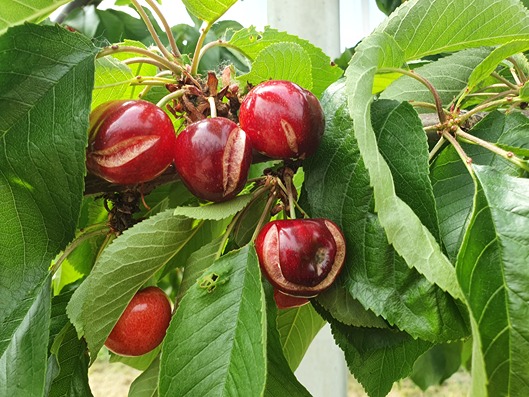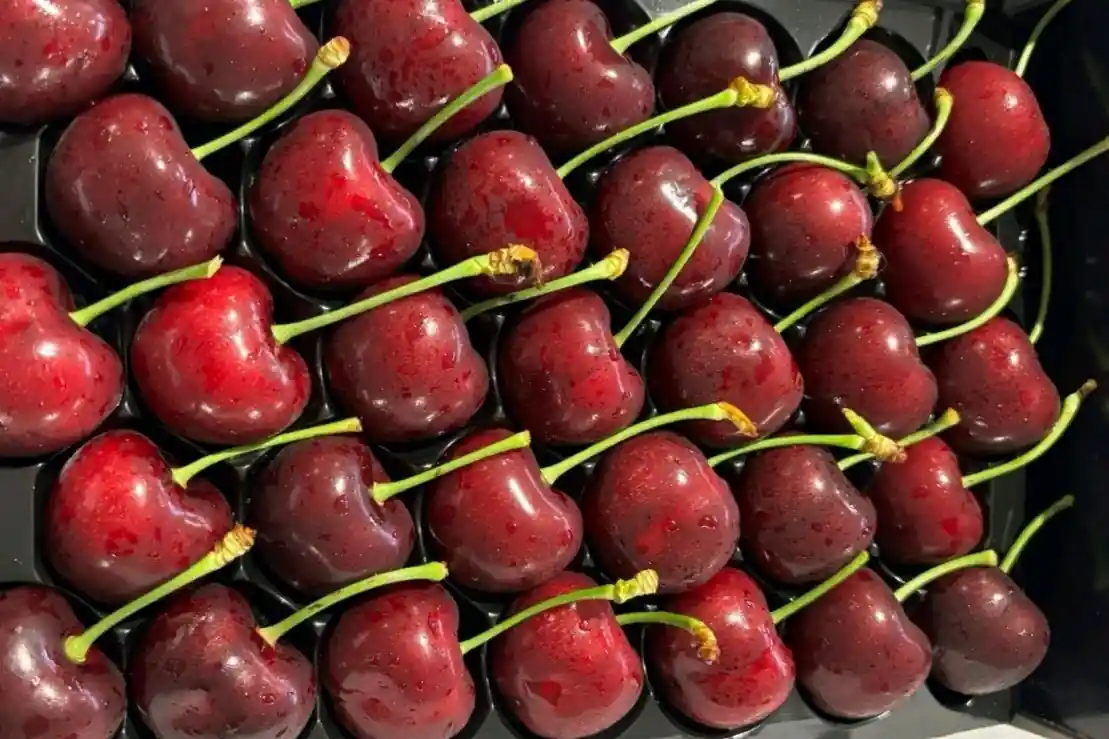Currently, the results of climate change models for our country align in various aspects that will alter the way fruit species are cultivated across Chile. Among these, the persistence of a gradual decrease in precipitation, rising air temperatures, and a significant drop in snow accumulation on the Andes Mountains are the most cited.
The change in these climatic factors will lead to many orchards not having sufficient water to meet their water needs at least at some points during the season.
It is surprising that, despite the high acceptance of adverse climate projections for the coming years by fruit growers and professionals, orchards still persist with extremely inefficient irrigation practices.
A survey conducted by a company dedicated to efficient water resource management in the Valparaiso region found that, despite the severe water crisis affecting agriculture in various parts of the region, nearly 90% of respondents did not use objective methods to determine water demand or irrigation frequency.
This situation is not unique to Valparaiso, as it is easy to observe that the most commonly used tool for defining irrigation criteria in national orchards remains the caliper and the subjective estimation of soil moisture by hand. Cherry cultivation in Chile extends over more than 2,400 km from the Coquimbo region to the Aysén region.
With a planted area of over 67,000 hectares, cherries have been planted in geographical areas where water availability for irrigation is highly contrasted with the magnitude of atmospheric evaporative demand. The lack of objective irrigation control can lead to very risky situations for plant productivity, especially in a changing climate like the current one.
For instance, in central Chile, it is common for irrigation management in cherry orchards to involve applying large amounts of water between flowering and harvest, but then to arbitrarily reduce the amount or frequency of irrigation after fruit harvest. The lack of data on the water status of the plant or soil can lead to a high percentage of severely stressed plants.
 Image 1: Percentage of water stress in plants. Source: Mundoagro.
Image 1: Percentage of water stress in plants. Source: Mundoagro.
A couple of seasons ago, our team at the Fruit Water Relations Laboratory of the Agronomy University assessed the severity of post-harvest water stress in a randomized block within a commercial Santina cherry orchard in the Ñuble region.
The orchard manager told us that after fruit harvest, he reduced the irrigation frequency from every other day to every three days. Our assessment results showed that, out of the total number of plants measured physiologically (stem water potential) in the orchard, 75% showed severe to very severe water stress (Figure 1).
Consequences of Water Stress
After fruit harvest, the main carbohydrate reserves are the storage organs: primarily the root system, followed by the trunk and then the tree's buds. Since the cherry tree is one of the first fruit trees to be harvested in Chile, the period of time during which the plants are fruitless often exceeds by several weeks the period when fruits grow and develop.
Therefore, the accumulation of reserve carbohydrates post-harvest is a process that, in terms of duration and physiological importance, requires optimal functioning, as ample carbohydrates are needed for adequate flowering and bud break.
Studies conducted by Dr. Victor Blanco have found that cherry trees subjected to very severe and prolonged post-harvest water stress after two seasons can experience about a 35% decrease in winter pruning weight, illustrating the impact of inadequate water status on the accumulation of plant reserves.
Unfortunately, the impact of ignoring the water status of the plant or soil on irrigation practices can worsen in a climate characterized by high variability. Last season, a commercial cherry orchard in the Pinto municipality showed high fruit drop and significant percentages of dehydration and collapse of the drupe a few days after fruit set (“pasma” of the cherry).
When we consulted the owners, they told us that last season they had very low water availability, which occurred during weeks characterized by high air temperatures (>30°C). This situation prevented them from completing the irrigation programs after fruit harvest, resulting in severe plant stress.
This, combined with an irregular accumulation of chilling hours, contributed to uneven and weak bud break, where many fruits did not have enough leaves to provide carbohydrates for the process of growth and development during the period when each fruit's growth potential is at its maximum (maximum relative growth rates at fruit set) (Photo 1).
Water Scenarios
In this context, a brief analysis of cherry cultivation in the various geographical areas where this fruit tree has established itself (central-northern, central-southern, and southern zones) can be an interesting exercise to describe the current water scenarios of fruit growing in Chile and potential management strategies.
Scenario 1: Insufficient water for irrigation.
Nella zona centro-settentrionale del Cile, con circa 120 ettari coltivati a ciliegio, la coltivazione di questo albero da frutto ha iniziato ad attirare una forte attenzione negli ultimi anni grazie alla produzione di ciliegie precoci, che raggiungono prezzi molto elevati nel mese di ottobre di ogni stagione.
In this scenario, cherry orchards are experiencing extreme water limitations, where, even in relatively rainy years, the availability of water for irrigation is extremely low.
Scenario 2: Limited water availability for part of the season.
In the central part of the country, where over 30,000 hectares of cherries are planted, precipitation and the resulting water availability for irrigation are higher compared to northern-central Chile.
However, in recent years, a combination of higher temperatures and reduced precipitation during the winter season, coupled with less snow accumulation in the upper parts of the region's water basins, has led to a drastic reduction in water availability for cherry irrigation starting from mid-summer.
This geographical area contains about 85% of the cherry orchards, making it the most important production area in Chile from a commercial perspective.
Scenario 3: Abundant water for irrigation throughout the season.
The southern part of the country is characterized by a high availability of water for irrigation and a moderate atmospheric evaporative demand, especially in cultivation areas close to large water bodies (lakes or rivers).
Strategies
Clearly, the marked differences in both water availability and evaporative demand make it impossible for a universal irrigation strategy for cherries. Therefore, the primary consideration in designing an irrigation strategy for cherries should likely be related to the amount of water available for irrigation during the season.
Scenarios 1 and 2: In the case of northern-central Chile and some locations in the central area, the scarce water availability for irrigation necessitates a highly precise water application strategy in determining both water demand and irrigation frequency, as high-value fruits are produced with an increasingly scarce resource. One of the irrigation techniques that can be used in this geographical area is deficit irrigation (DI).
This technique is defined as applying an amount of irrigation water that is less than the maximum amount of water required by the crop (ETc), controlling aspects such as the timing, duration, and severity of the water deficit application. From a physiological standpoint, one of the major benefits of DI is the increased water productivity, as high volumes of fruit are produced with less water expenditure compared to conventional irrigation strategies.
For DI to be successful, correct technology for orchards and adequate training of the human resources involved in orchard irrigation (agricultural extension process) are essential. A very interesting aspect of DI is that, as plants are voluntarily subjected to water deficit, trees exhibit variable levels of water stress throughout the season.
Thus, within this irrigation strategy, water stress is not avoided, as the best cost-effectiveness ratio of applied irrigation water is achieved when plants are under water stress (Figure 2).
 Image 2: Irrigation strategies.
Image 2: Irrigation strategies.
This irrigation strategy requires integrating a deep understanding of the fruiting habits and physiological responses of the cultivar/rootstock combination to water stress. This is because DI is applied at a time when the yield and fruit quality are insensitive to the severity and duration of the water stress applied.
For instance, in table grapes, the period of greatest reproductive sensitivity to water stress occurs near flowering, which in central Chile tends to happen in November. In cherries, the period of greatest sensitivity to yield occurs near the “straw fruit” stage, when flower bud induction takes place.
Two other critical periods when DI should not be applied to cherries are during fruit set and near fruit set (the start of growth and development phase III). Fruit set is the time when drupe presents the highest relative growth rates, determining the growth potential of each fruit on the tree. Any disruption in cell division or elongation processes during this period will reflect in smaller fruit size.
In the case of color change, which marks the sharp increase in soluble solids concentration in the fruit, strong water stress followed by abundant plant rehydration can lead to high rates of lateral cracking. If strong rehydration occurs while the cherry still maintains vascular continuity with the rest of the plant, the drastic change in the plant and fruit's water status can result in high cracking rates.
In early cherries of northern-central Chile, a grower contacted us a few seasons ago to tell us that, despite the evident water shortage and precipitation during spring in their cultivation area, the rates of lateral cracking were over 30%.
For these reasons, DI in cherries should be delayed, as it is more feasible to apply it after harvest, when there are no fruits, so fruit size cannot be affected, and several weeks have passed since flower induction.
È importante sottolineare che la RDC tardiva non equivale alla pratica di interrompere l'irrigazione senza alcun controllo dopo la raccolta, poiché nella RDC c'è un controllo preciso della gravità dello stress idrico, del momento dell'applicazione e della durata della pratica.
Clearly, the application of DI requires very precise management of the plant's water status, so the success of this strategy depends on the use of tools that measure this variable (Photo 2). Among these, the pressure chamber (Scholander-type pump) is the most widely used equipment globally, both in research and commercial activities.
This device, which is very easy to use, allows for real-time assessment of the severity of water stress reached across multiple plants and, with this, to determine the maximum levels of water stress tolerable by the plant in a DI program.
In Chile, our Fruit Water Relations Lab at U de C, in collaboration with Olivos Spa and Giddins Cerasus SA through the FIA project, has been able to validate a post-harvest late DI strategy that can be managed not only with the pressure chamber but also with new water stress measurement technologies, such as the plant tensiometer.
This project, funded by the AIF through the regional government of the Libertador General Bernardo O'Higgins region, achieved a water saving of nearly 20% without affecting yield or fruit quality over more than three seasons of evaluation. Similarly, bud break and flowering were not impacted by the severity of the water stress achieved with the implementation of DI, providing greater certainty for using this practice in future seasons.
Scenario 3: In some locations in the central, central-southern, and southern regions, the greater availability of irrigation water during spring leads to conditions of high vegetative growth (leaf area index >4.0). Along with a moderate to high evaporative demand, it is likely that transpiration rates will be high. In these areas, two approaches to cherry irrigation are commonly used.
On one hand, those with sufficient water for the entire season often apply an amount of irrigation close to or exceeding the maximum water requirement of the orchard (ETc close to 8,000 m³/ha/year). In these cases, water application can reach 10,000 m³/ha/year.
Although cherry plants can show high yields under these irrigation conditions, the profitability of the orchard is not optimal due to higher energy costs for transporting water from extraction points (deep wells over 50 m), increased nutrient losses due to leaching, higher costs for weed control, increased disease pressure from bacterial cankers and Phytophthora spp., and increased physiological problems associated with soil oxygen deficiency (poor root growth, stomatal closure, reduced photosynthesis, Fe or Al toxicity, and soft fruit, among others).
Thus, it can be stated that excessive application of irrigation water reduces the profitability of the orchard (Figure 2).
A rarely mentioned aspect of applying high volumes of irrigation water is the opportunity cost, defined as the value of the alternative that is foregone when making a decision, which includes the benefits that could have been obtained if that option had been chosen.
In simple terms, what else could have been done with the excess water? For example, if a mature cherry orchard in Rancagua has a cumulative ETc of 7,000 m³/ha/year but 9,000 m³/ha/year is applied, the overirrigation of 3.5 hectares of cherries would be enough to irrigate one hectare of cherries in full production for a season.
The awareness of the opportunity cost of water is the fundamental basis for applying DI, even under assured water availability conditions. If DI is not desired, the strategy to follow is simply to avoid over-irrigating!
To achieve this, it is essential:
- to accurately record the amount of irrigated water using flow meters;
- to accurately estimate the maximum water requirement (ETc) based on the vegetative development of the canopy.
For this, it is essential to use well-maintained and installed weather stations. This last point is probably one of the weakest aspects of our fruit farming, as the typical installation of private agro-meteorological stations involves placing them in inadequate locations, such as within an orchard, near roads, next to caretaker huts, offices, or sheds.
Data from stations installed under these conditions are absolutely useless for estimating demand, and their use for this purpose often leads to over-irrigation errors. Stations used to estimate ETc must be installed in a lawn with a reference species under optimal growth conditions, with no shade for 365 days a year, at a maximum height of 12 cm, and away from buildings, water channels, and roads, among others.
If, in addition to determining the amount of water, elements that support defining the irrigation frequency, such as soil moisture probes and/or the pressure chamber, are added, the probability of over-irrigation will be minimal.
Finally, optimizing irrigation in cherries, as in other fruit trees, depends on the correct use of technologies that allow us to objectively manage water resources, leaving subjectivity as a support tool rather than a decision-making criterion.
The success of implementing any change in irrigation practices requires an adequate dissemination process, where the recipients (producers, agronomists, technicians, and operators) are known, and together with them, the steps to implement and adopt the proposed innovations are defined.
Cherry farming in Chile is not only an important economic activity but also a lifestyle that gives identity to our territory. Developing a fruit farming approach that is economically, socially, and environmentally sustainable is the only way to be competitive and advanced. The invitation has been made for this to happen; now we just need to dare.
Source: Mundoagro
Image: SL Fruit Service; Mundoagro
Cherry Times - All rights reserved














